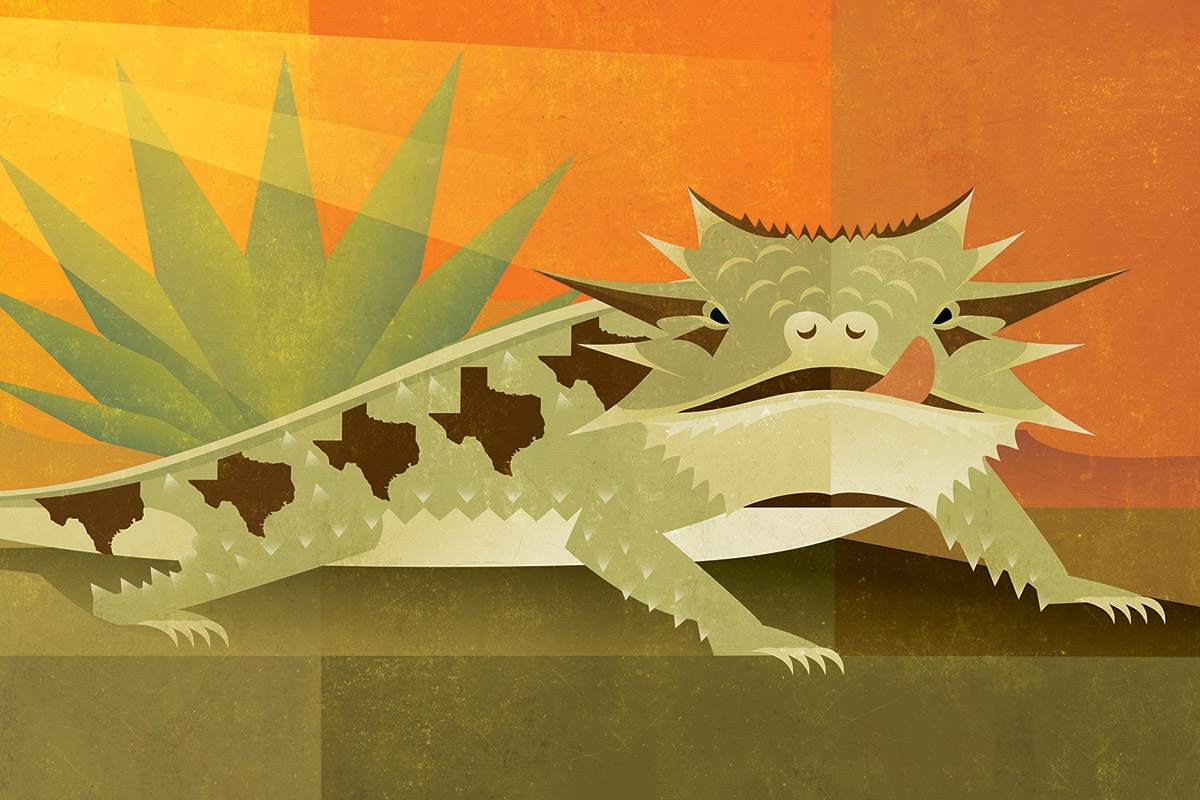Inch by inch, wildlife biologist Jim Gallagher eyeballed the grassy turf around his boots. So far, several days of scouring the same plot at Mason Mountain Wildlife Management Area had turned up nothing. Still, he kept up his search. Alert to any movement, Gallagher scanned dry patches of dirt, clumps of buffalo grass and trailing morning-glory vines.
Then a spiny critter no bigger than a quarter scuttled across the clay loam. “Oh, my God,” he exclaimed. “There’s a horned lizard!”
The tiny reptile was the first of several that Gallagher would count in April 2019. For the first time, Texas horned lizards—captive-bred at the Fort Worth Zoo in 2018 and released as hatchlings into the wild—had successfully hibernated through winter and survived into spring. Researchers celebrated the news.
“We were jazzed,” says Diane Barber, the zoo’s curator of ectotherms (coldblooded animals). “That meant more of the 132 that we released probably survived, too.” Since 2000, she and her team, in collaboration with the Texas Parks and Wildlife Department, Texas Christian University and other Texas zoos, have pioneered care and breeding techniques for wild-caught horned lizards. Together, the coalition is working to reverse the dwindling numbers of the threatened species, which are also called horned frogs and horned toads.
More than 40 years ago, “horny toads” thrived in Texas. Back then, the fierce-looking mini dinosaurs ranged across the state. Countless youngsters caught them near their homes. Few people realized the lizards ate the red harvester ants that bulldozed bald spots in yards and landscapes.
Enter pesticides, urbanization and fire ants, to name a few culprits. Horned lizards began to disappear. Today, they’re mostly gone east of a line that can be drawn from Fort Worth to Corpus Christi. “I believe loss of habitat is the biggest reason for their decline,” says Leslie Nossaman, president of the Horned Lizard Conservation Society. “Plus, people still kill harvester ants, which provide a lot of food for horned lizards.”
Since 1991, the conservation society has spread awareness of 17 North American species of horned lizards, found from southern Mexico into southern Canada. Most are protected. Texas claims three species. Best known is the Texas horned lizard, designated as the state reptile in 1993. Two other species live in far west regions: the greater short-horned and the roundtail horned.
“We have permitted handlers who rehabilitate injured lizards and relocate ones that get picked up,” Nossaman says. “People should never pick up horned lizards in the wild. They do not make good pets and will not survive if taken out of their environment. But if they’ve accidentally picked one up, we’ll help them relocate it to the right habitat.”
The conservation society also funds horned lizard research and conservation projects. For example, one of six grants awarded in 2019 underwrote a pilot project that’s training dogs to sniff out horned lizards in the field. “We plan to use these detection dogs to determine if a site already has an existing population of horned lizards,” says Andy Gluesenkamp, director of conservation and research at the San Antonio Zoo. “They’ll also help us find wild lizards for our breeding program and search for released lizards so we can monitor their success.”
Conservation efforts at the zoo have focused on southern populations of horned lizards, while similar projects at the Fort Worth and Dallas zoos work with northern populations. The populations differ genetically, according to biology professor Dean Williams, who’s mapped out lizard genetics across the state and leads TCU’s Horny Toad Project.
Meanwhile, Gluesenkamp aims to produce hundreds of hatchlings in the zoo’s “lizard factory,” a climate-controlled laboratory for breeding and rearing baby horned lizards. Females typically lay clutches of 12–30 eggs once a year. “Our plan is to release 100 young lizards per site per year for three years,” he says. “Then we’ll follow up with 25 hatchlings every other year.” Sites must be 200–250 acres in size and encompass high-quality lizard habitat of native grasses, shrubs, harvester ants or desert termites, and few or no fire ants. So far, two locations in Blanco County are being managed for horned lizard releases.
In 2019, San Miguel Electric Cooperative donated $10,000 toward Gluesenkamp’s research. “Since the 1980s, we have surveyed for horned lizards in areas we plan to mine,” says Dave Burris, fuels manager with the San Miguel Lignite Mine in Atascosa and McMullen counties. “We perform relocations for potentially affected species and also make our sites available to horned lizard researchers at Texas Christian University.”
So do folks who live in Kenedy, the horned lizard capital of Texas. Oodles of the reptiles once lived in town. Though their numbers have shrunk, local love for them hasn’t. “Every summer, we host scientists from TCU who do DNA studies on horned toads here in Karnes County,” says Wade Phelps, a dentist who oversees the Horned Toad Club of Kenedy. “We’re also carving out a horned toad habitat demonstration site in our new Escondido Creek Parkway project.”
The future looks brighter for the Texas horned lizard. “They’re a keystone species,” notes Nathan Rains, a wildlife diversity biologist with the TPWD. “The habitat they prefer benefits quail, turkey and songbirds, too. Since we all love horned lizards, it’s a win-win for everyone.”
Sheryl Smith-Rodgers of Blanco spent many hours as a child playing with horned lizards found around her Corpus Christi home.


